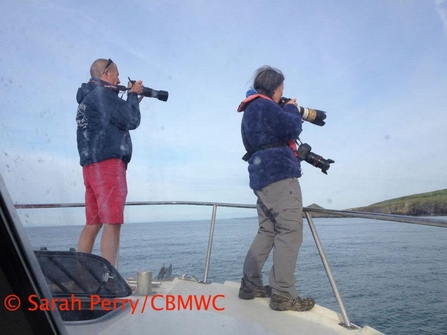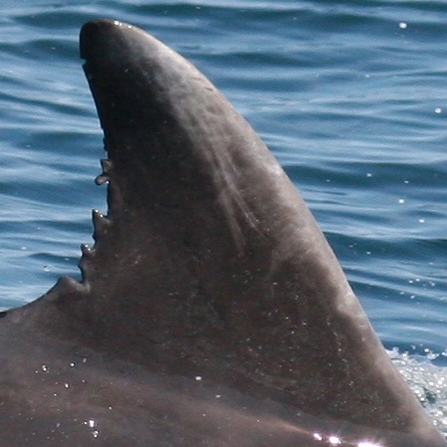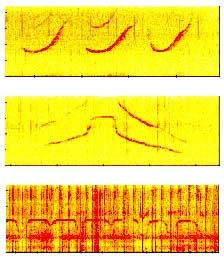ShoreFin 2016 Report
Our research and methods
Dolphin and porpoise surveys
In south and west Wales we have arguably some of the best coastlines in the world. Rich in wildlife and stunning in character the seas which border our patch are teeming with life. Where the Gulf Stream meets the colder waters that surround our islands there is a rich food source.
With that rich food source comes some of the best dolphin and porpoise watching you could imagine. With both resident and transitory populations these cetaceans are often seen swimming around our shores.
Cardigan Bay Marine Wildlife Centre is home to our Living Seas team, they are researching the occurrence and behaviour of the dolphins and porpoises and you can help by joining them on a survey trip. Our research trips are run by Dolphin Survey Boat Trips, when you pay for your trip out on the boat you are enabling our volunteers and Living Seas staff to join them to collect important data. What is a fantastic day out for you contributes to our essential long term research work into our marine environment.

Boat-based surveys
Dolphin Survey Boat Trips’ Sulaire and Anna Lloyd are both used as CBMWC research vessels from New Quay harbour. Boat surveys usually follow a set route within the Cardigan Bay Special Area of Conservation (SAC). A volunteer researcher from CBMWC joins each boat trip and is responsible for systematically recording effort (position and environmental information) and sightings data (of large marine animals) on a series of survey forms.
The effort form
An effort line is completed every 15 minutes or every time one of the following survey conditions changes:
- Speed
- Boat course (more than 10°)
- Effort type
- Precipitation
- Sea state
- Wind direction
- Wind force
There are four effort types:
- CW – casual watch. The researcher is observing from the wheelhouse or passenger area
- DS – dedicated search. The researcher is observing from the roof (but not a line transect)
- ID – photo-ID work is occurring
- LT – line transect. The researcher is on the roof and the boat is following a predetermined route through the SAC
The researcher uses a handheld GPS (Global Positioning System) to gather the positional data (latitude and longitude) and also speed, course and time.
For each effort line the researcher also records any precipitation (e.g. rain or mist), visibility, sea state, swell height, wind direction and force, cloud cover and glare and any other boats that are observed in the area.
The sightings form
The sightings form is only used when a large marine animal (e.g. bottlenose dolphin, Atlantic grey seal, harbour porpoise, whale, basking shark or leatherback turtle) is seen. The following information on the sightings form is filled in immediately:
- Latitude and longitude, taken from the handheld GPS
- Angle from boat
- Distance in metres to the animal
Once this data is complete, then the rest of the sightings form is filled in.
- Species
- Total number
- Number of adults, juveniles, calves and newborns
- Behaviour and/or direction of travel
- Any large congregations of birds seen in close proximity to the sighting and their approximate number and behaviour
Land-based surveys
CBMWC volunteers assist Ceredigion County Council with their annual Dolphin Watch that takes place from six land-based sites along the coast – Aberystwyth, New Quay harbour, Bird’s Rock, Ynys Lochtyn, Aberporth and Mwnt.
Initiated by Ceredigion County Council in 1994 amidst fears that relatively high levels of boat activity were causing disturbance to bottlenose dolphins and other marine wildlife in the area, the Dolphin Watch project has developed over the years and now aims to do the following:
- To improve our understanding of bottlenose dolphins site use within the SAC
- To monitor trends in dolphin occurrence and levels of boat traffic
- To assess the effectiveness and need of management measures that aim to reduce the risk of disturbance or injury to dolphins by boats
- To increase public awareness and appreciation of the marine wildlife in Cardigan Bay
CBMWC volunteers are responsible for monitoring the New Quay harbour survey area, and they do so year round. From Easter to November surveys are conducted daily from 9am to 5pm (7am to 7pm when light levels permit), whatever the weather, with volunteers working in two hour shifts. The data collected by CBMWC volunteers at New Quay harbour are provided to the Dolphin Watch project each year.
Observers split their shift into eight 15 minute periods. For each period they mark the location of any dolphins they see, how many adults and young animals are in the group and their probable activity. This includes several feeding behaviours and travelling activities, and will hopefully point out which parts of the bay the dolphins are just passing through and where feeding hotspots are. The location and behaviour of any harbour porpoise and Atlantic grey seals are also noted.
Photo-ID
Photo-identification (photo-ID) is a simple, powerful, non-invasive technique aiding the study of bottlenose dolphins in Cardigan Bay.
In the early 1970s, scientist found out that it was possible to recognise individual whales and dolphins from good quality photographs. From pictures, killer whales are usually recognised by their dorsal fins and saddle patches, sperm whales by irregularities in the edge of their flukes, humpback whales by the black and white pattern underneath their flukes and blue whales by the mottled patterns of their bodies. The Cardigan Bay bottlenose dolphins are recognised by their dorsal fins.
Photo-identification of bottlenose dolphins
All bottlenose dolphins are different and individuals can be recognised by the markings on their dorsal fins. These markings can be nicks or notches to the fin, natural blemishes on the animal’s skin, or scars and rake marks from the teeth of other dolphins. If photographed sufficiently well then individual dolphins can be identified. The perfect bottlenose dolphin photo-identification image is of the dorsal fin at close range in sufficient light. Ideally photographs are taken of the left and right sides of the dorsal fin so there are two photos per animal as this will help with future identification.
How does photo-identification help with CBMWC’s bottlenose dolphin research?
Photo-identification of bottlenose dolphins was first conducted in Cardigan Bay in the 1980s and repeated in the early 1990s and in 2001. In 2005 we established our annual Photo Identification Catalogue, in cooperation with other Welsh marine organisations. Now each ID photo we take is analysed to look for a match with the animals already documented in our catalogue and any new individuals are given their own ID number.
This matching process is very important as it allows us to estimate the bottlenose dolphin population within the Cardigan Bay Special Area of Conservation (SAC) and allows for any changes in the population to be monitored and reasons for any changes investigated. Movements and migration patterns of the dolphins can also be studied along with life histories, as mothers and their calves can also be identified and the calves tracked as they grow.

Acoustic recordings
Sound plays a vital role in the lives of dolphins and porpoises. They use echolocation to navigate and to find objects, such as prey and group members. In addition, bottlenose dolphins use signature whistles, which are individually unique signals, used to keep contact with group members, especially important for mother-calf pairs.
Sound pollution is an extensive problem in marine habitats. Coastal species, such as bottlenose dolphins and harbour porpoises, are especially affected because they live in habitats where an increasing amount of pleasure crafts operate. Unfortunately, these small fast boats usually make sounds in the same frequency band as the ones dolphins and porpoise use. This can have potential effects such as loss of contact with group members and reduced feeding success.

Spectrograms are visual illustrations of sounds, depicting the frequency at the y-axis and the time at the x-axis.
Seen top and middle are the whistles of two different bottlenose dolphins. Below is the whistle of a third dolphin recorded in the vicinity of a boat. This figure illustrates how sound pollution can mask the sounds used by the animals.
The creation of a sound library to store such information
would consist of three phases:
A. The recording of sounds
B. Analysing and selecting required sounds
C. The building of the database
A sound library consists of sound files, spectrograms and relevant data, such as recording time and the place and possible origin of the sounds.

